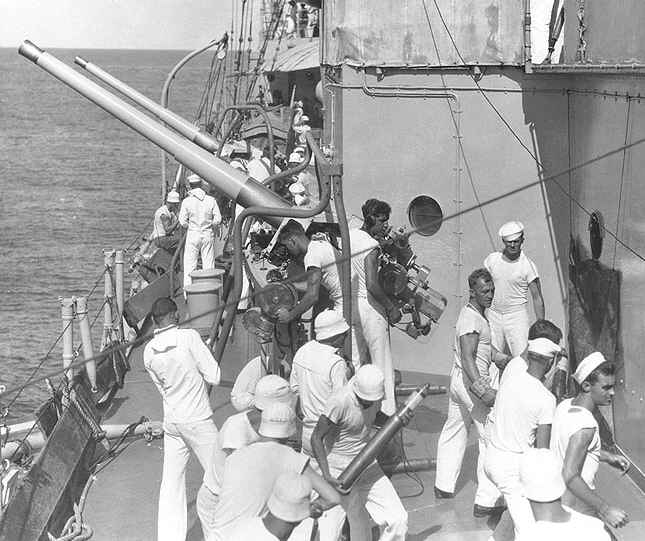
A series of 3" (7.62 cm) AA guns dating back to World War I. These were of a simpler construction than the previous 3" (7.62 cm) guns and successive marks were to improved designs. This gun was widely used up to the 1930s, but were then gradually replaced on larger ships by 5"/25 (12.7 cm) single mountings and later by Bofors 40 mm in twin and quad mountings. However, the battleships New York and Arkansas still had them as late as 1943. During World War II this weapon was extensively used on smaller warships such as destroyer escorts, submarines and auxiliaries along with many merchant ships with about 14,000 guns being produced between 1940 and 1945.
Although considered to be dual-purpose weapons, these guns had limited effectiveness in either role, as they fired light-weight shells and were manually operated, meaning that they could not be fitted for RPC. However, the invention of the VT fuze and the addition late in the war of power operation together with the Mark 51 director system greatly improved their effectiveness as AAA guns, giving the later marks of this weapon a new lease on life. In the fall of 1945, CinCPac considered that a 3"/50 (7.62 cm) with director control, RPC and VT ammunition was superior to a twin Bofors 40 mm mount and at least equivalent to a quad Bofors 40 mm mount.
There was a design defect in the breech block of the Mark 22. When the breech block was closed, the firing pin could stick out and strike the cartridge igniter and accidentally fire the gun. Navy ordnance publications for this weapon recommended lubricating the firing mechanism with light machine oil instead of grease as a correction for the problem, but this was not always successful.
The Mark 10 was derived from the 3"/50 (7.62 cm) Mark 6 with a modified breech that was of the vertical sliding wedge type. Marks 10, 17 and 20 were built-up guns with A tube, jacket and hoop. Mark 17 guns were intended for wet mountings and had the bore and external working surfaces chrome plated and the chase painted with red lead. Mark 18 was intended for wet mountings and manufactured from a copper-nickel alloy with A tube, jacket, screwed and shrunk breech housing. Mark 19 had monobloc construction and thus a lighter gun. Marks 21 and 22 were very similar apart from a collar on the chase on the Mark 22. This was intended for use with a concentric counter-recoil spring, which was used only on Mark 24 mountings during World War II. However, this feature led to this barrel being selected for the post-war automatic mountings. See the data page on the 3"/50RF (7.62 cm) for additional information. Both the Mark 21 and the Mark 22 had chromium plated bores and autofretted monobloc barrels secured to the breech housings by bayonet joints. All marks used a semi-automatic vertical sliding breech block.
The data that follows is for the Mark 21 Mod 0 unless otherwise specified.
| Designation | 3"/50 (7.62 cm) Marks 10, 17, 18, 19, 20, 21 and 22 |
|---|---|
| Ship Class Used On | Many ships 1915 through 1945 |
| Date Of Design | Mark 10: 1914
Mark 22: 1944 |
| Date In Service | Mark 10: 1915
Mark 22: 1944 |
| Gun Weight | 1,760 lbs. (798 kg) |
| Gun Length oa | 159.7 in (4.055 m) |
| Bore Length | 150.3 in (3.816 m) |
| Rifling Length | 126.1 in (3.204 m) |
| Grooves | (24) 0.03 in deep (0.76 mm) |
| Lands | N/A |
| Twist | Mark 10: Increasing RH 0 to 1 in 25
Mark 18: Uniform RH 1 in 32 Mark 19: Uniform RH 1 in 32 Mark 20 Mod 0: Increasing RH 0 to 1 in 25 Mark 20 Mod 1: Uniform RH 1 in 25 Mark 21 Mod 0: Uniform RH 1 in 32 Others: N/A |
| Chamber Volume | 217 in3 (3.56 dm3) |
| Rate Of Fire | 15 - 20 rounds per minute |
| Type | Fixed |
|---|---|
| Weight of Complete Round | All: 24 lbs. (10.9 kg) |
| Projectile Types and Weights | AP Mark 29 Mods 1 and 2: 13.1 lbs. (5.9 kg)
HC Mark 27 Mod 1 1: 13 lbs. (5.9 kg) AA Mark 23 Mods 1 and 3 1: 13 lbs. (5.9 kg) AA Mark 27 Mods 1 and 4 1: 13 lbs. (5.9 kg) AA VT Mark 31 Mod 1: 13 lbs. (5.9 kg) Illum Mark 21 Mods 1 and 3: 13 lbs. (5.9 kg) Illum Mark 24 Mod 1: 13 lbs. (5.9 kg) Illum Mark 25 Mod 1: 13 lbs. (5.9 kg) |
| Bursting Charge | AP 2: 0.3 lbs. (0.14 kg) Explosive D
HC: 0.74 lbs. (0.34 kg) Cast TNT AA: 0.74 lbs. (0.34 kg) Cast TNT AA VT: 0.54 lbs. (0.24 kg) Cast TNT, Comp. A |
| Projectile Length | AP: 12.16 in (30.9 cm)
HC and AA (including nose fuze): 12.13 in (30.8 cm) AA VT (including nose fuze): 12.22 in (31.0 cm) |
| Cartridge Case Type, Size and Empty Weight | Mark 3 Mods 0 and 3: Brass, 76.2 x 595 mm, 7.0 lbs. (3.18 kg)
Mark 3 Mod 2: Brass, 76.2 x 595 mm, 7.88 lbs. (3.57 kg) Mark 7: Brass, 76.2 x 584 mm, 7.0 lbs. (3.18 kg) Mark 9: Steel, 76.2 x 584 mm, 6.54 lbs. (2.97 kg) |
| Propellant Charge 3 | 3.7 lbs. (1.68 kg) SPD 033
4.0 lbs. (1.81 kg) SPD or SPDN |
| Muzzle Velocity | 2,700 fps (823 mps) |
| Working Pressure | 17.0 tons/in2 (2,680 kg/cm2) |
| Approximate Barrel Life | 4,300 rounds 4 |
| Ammunition stowage per gun | N/A |
- ^1.11.21.3The AA Mark 23 and its associated Cartridge Case Mark 3 were considered to be obsolete by the end of World War II. HC Mark 27 and AA Mark 27 were the same projectiles but assembled with different fuzes. These 3" (7.62 cm) HC rounds were unique in that they were the only ones of that type issued by the USN that did not have a base fuze in addition to a nose fuze.
- ^AP was originally issued without any explosive filler and used a tracer-only base fuze. Explosive was added sometime during the 1930s and was then given the Army Base Fuze M66A1.
- ^Some SPD and SPDN cartridges had flashless pellets added which gave them a "reduced" flash.
- ^Barrel Life figure is for guns with chrome plated bores. Non-plated guns would have been about 3,000 rounds. Wet guns are also noted as having less life than other chrome plated guns, but I lack data for these.
| Elevation | Range | Angle of Fall | Time of Flight | Striking Velocity | Maximum Ordinate |
|---|---|---|---|---|---|
| 1.57 degrees | 3,000 yards (2,740 m) | 2.43 degrees | 4.21 seconds | 1,687 fps (514 mps) | 70 feet (21 m) |
| 3.87 degrees | 5,000 yards (4,572 m) | 6.52 degrees | 8.50 seconds | 1,191 fps (363 mps) | 296 feet (402 m) |
| 13.92 degrees | 10,000 yards (9,144 m) | 27.58 degrees | 25.52 seconds | 808 fps (246 mps) | 2,880 feet (878 m) |
| 33.10 degrees | 14,000 yards (12,802 m) | 54.83 degrees | 48.80 seconds | 841 fps (256 mps) | 10,445 feet (3,184 m) |
| 43.03 degrees | 14,590 yards (13,341 m) | 63.28 degrees | 59.48 seconds | 884 fps (269 mps) | 15,010 feet (4,575 m) |
| 52.73 degrees | 14,000 yards (12,802 m) | 69.82 degrees | 68.90 seconds | 916 fps (279 mps) | 19,640 feet (5,986 m) |
| 58.68 degrees | 13,000 yards (11,887 m) | 73.37 degrees | 74.00 seconds | 841 fps (256 mps) | 22,350 feet (6,809 m) |
| 85.00 degrees | N/A | N/A | N/A | N/A | 29,800 feet (9,083 m) |
| Designation | Dry Mountings 2a For Mark 10 guns: Mark 11 For Mark 20 guns: Mark 20 For Mark 21 and 22 guns: Marks 22, 24 3a and 26 4a Wet mountings (submarines)
|
|---|---|
| Weight | 3.0 to 4.2 tons (3.1 to 4.3 mt) |
| Elevation | Most mountings: -15 / +85 degrees
SP wet mount for submarines: -15 / +40 degrees |
| Elevation Rate | Manually operated, only |
| Train | 360 degrees |
| Train Rate | Manually operated, only |
| Gun recoil | 12.0 in (30.5 cm) |
- Bourrelet diameter was 2.980 inches (7.57 cm).
- ^Battleships in the 1920s carried as many as ten of these weapons.
- ^The Mark 24 was introduced late in World War II and was an entirely new DP type. This mounting was designed by Northern Pump and characterized by a counter-recoil spring wrapped around the base of the barrel. Weight was 8,235 lbs. (3,735 kg).
- ^Almost all of these marks were manually worked. In 1945, Mark 22 mounts were given power drives and then designated as Mark 26 with elevation speed of 24 degrees per second and training speed of 30 degrees per second.

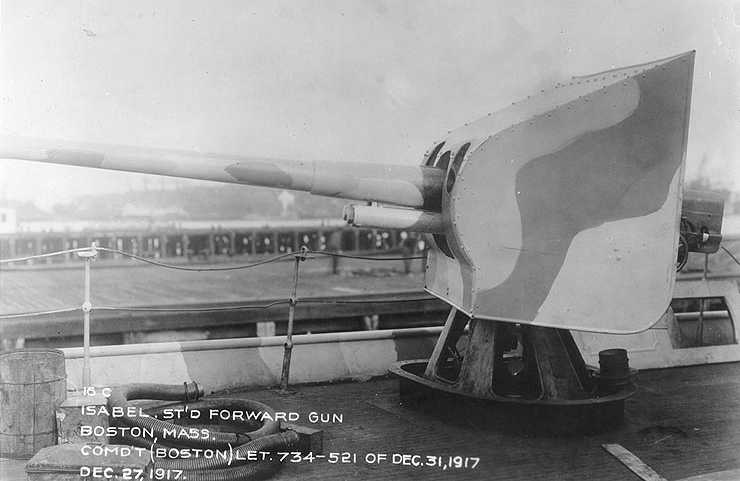
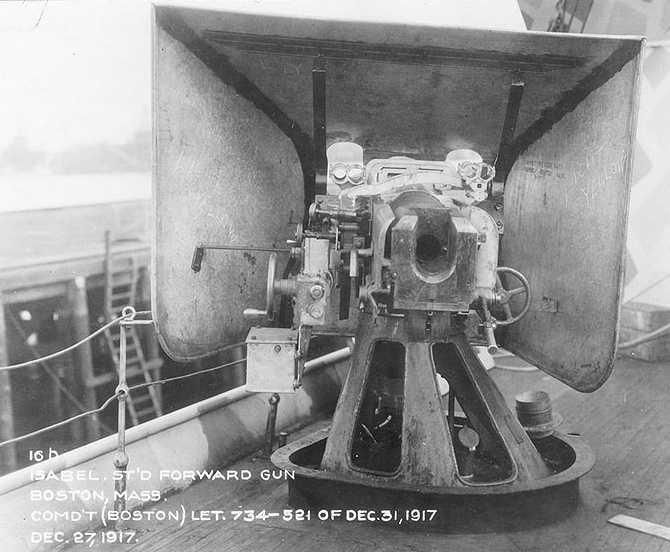
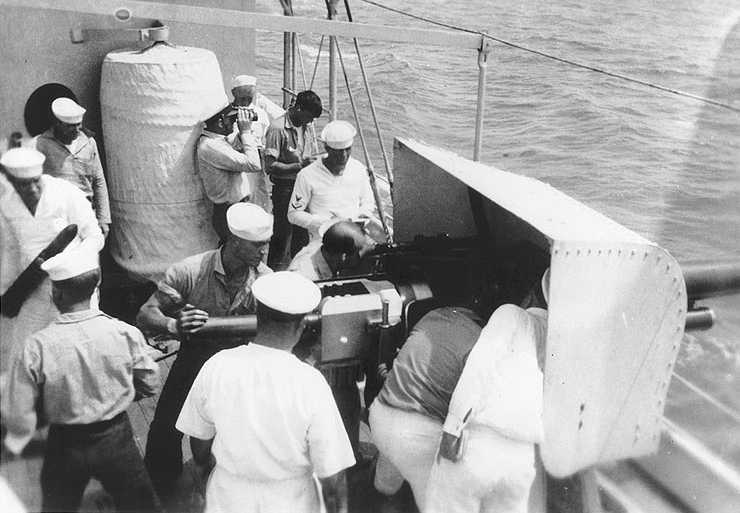
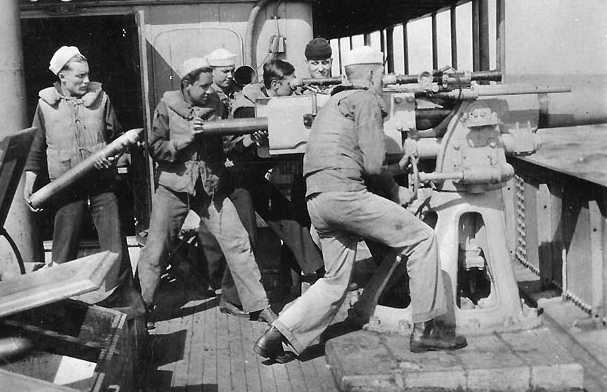
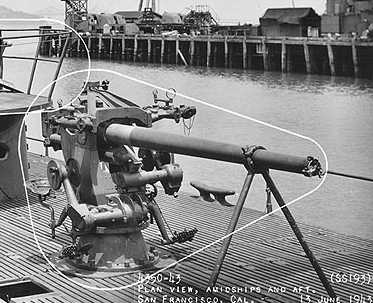


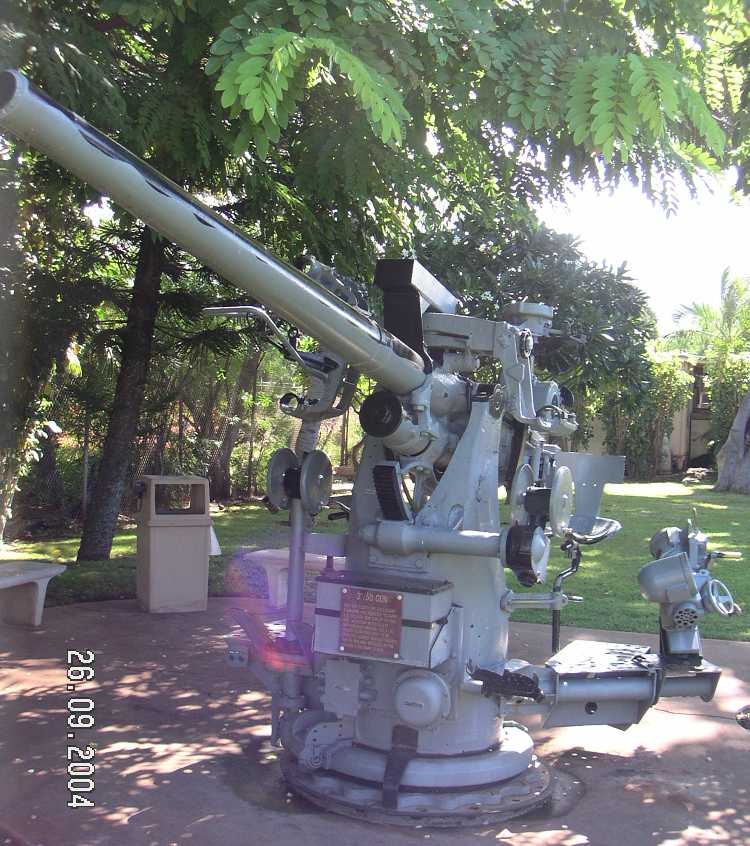
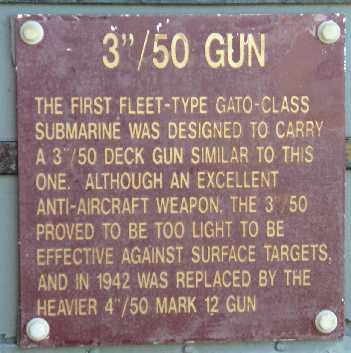


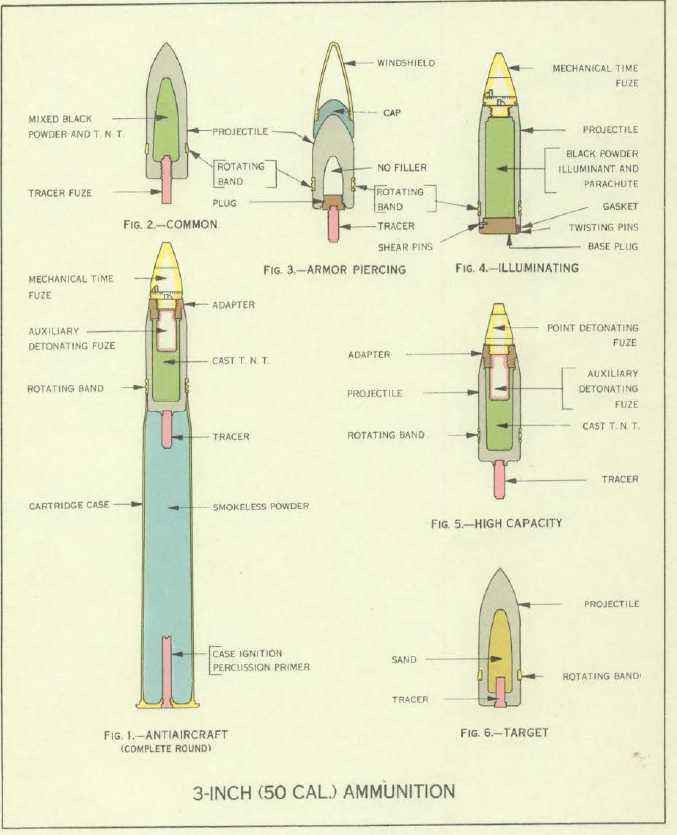
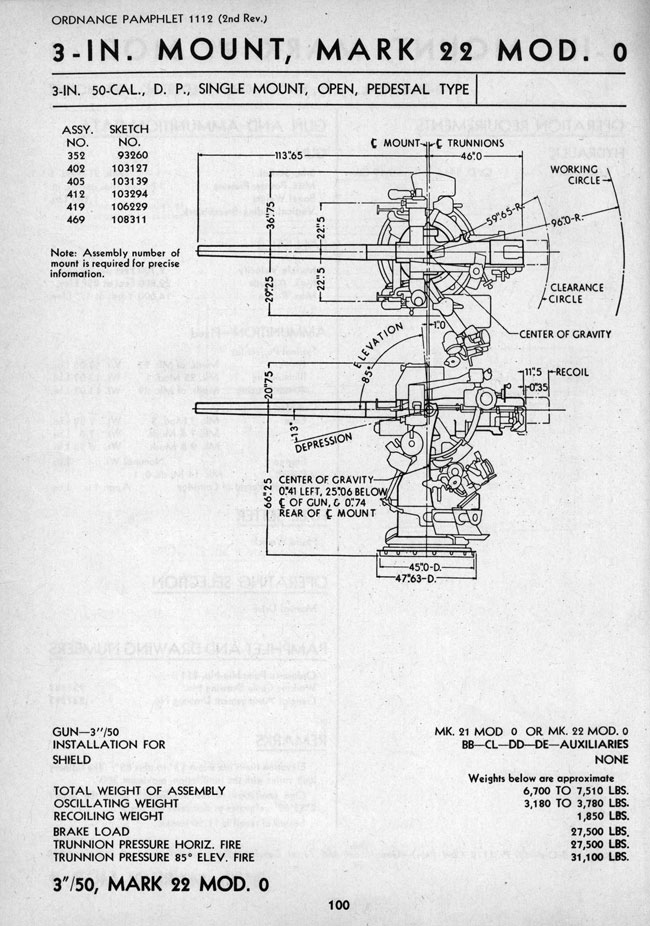
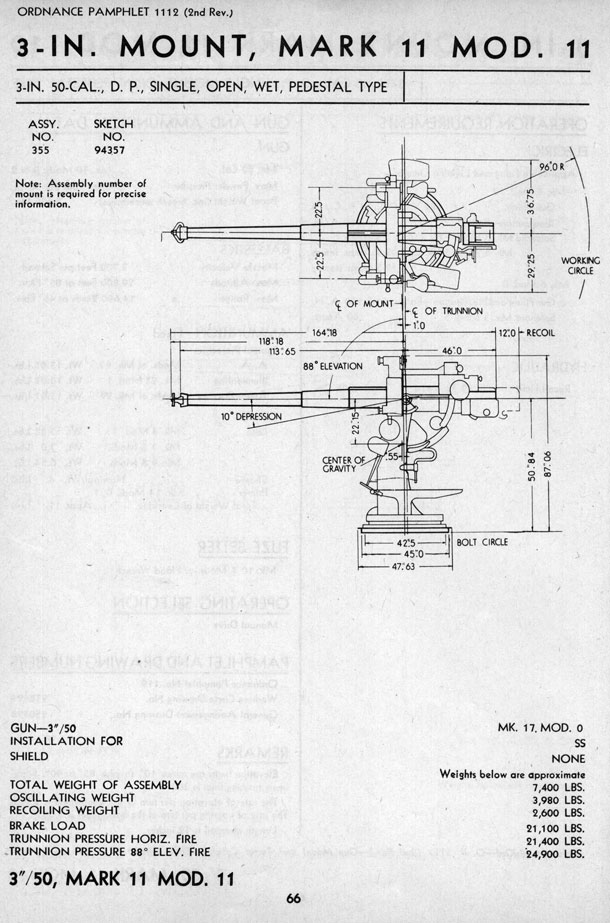
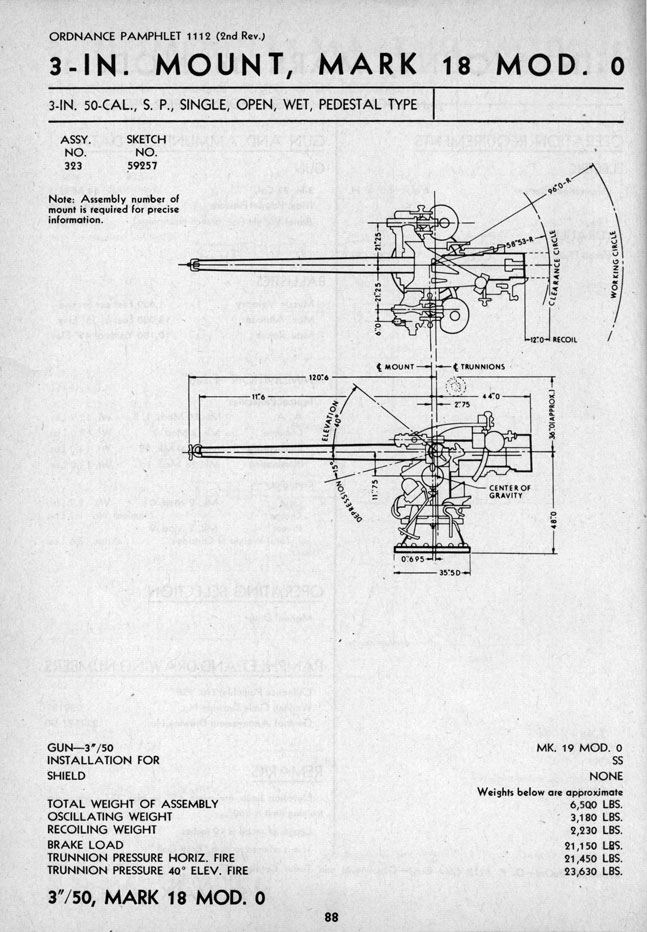
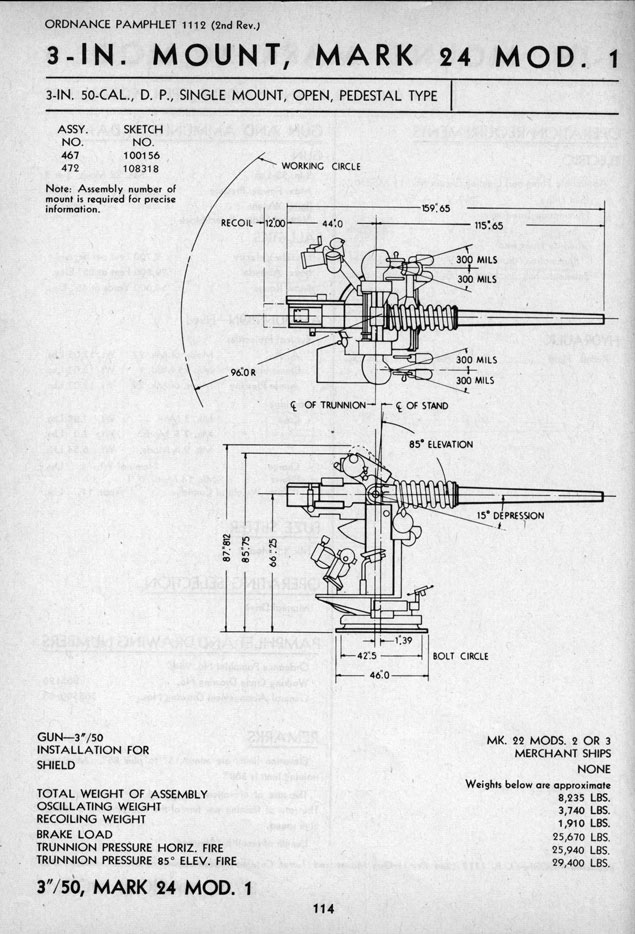
"Naval Weapons of World War Two" by John Campbell
"US Naval Weapons" by Norman Friedman
---
"U.S. Navy Bureau of Ordnance in World War II" by Lt. Cmdr. Buford Rowland, USNR, and Lt. William B. Boyd, USNR
"Navy Ordnance Activities: World War, 1917-1918" by Navy Dept, United States, Bureau of Ordnance
"Range and Ballistic Tables 1935" by U.S. Department of Ordnance and Gunnery
"Ammunition: Instructions for the Naval Service: Ordnance Pamphlet 4 - May 1943" by Department of the Navy
"Abridged Range Tables for U.S. Naval Guns: Ordnance Pamphlet No. 1188, 13 June 1944" by Bureau of Ordnance (BuOrd), Department of the Navy
"U.S. Explosive Ordnance - Ordnance Pamphlet No. 1664 - May 1947" by Bureau of Ordnance (BuOrd), Department of the Navy
---
Gene Slover's Navy Pages
31 May 2008 - Benchmark
14 January 2011 - Added data reference. Added cutaway sketch.
20 November 2015 - Corrected typographical
23 October 2021 - Converted to HTML 5 format, added mounting sketches
09 August 2023 - Revised range table
25 March 2024 - Corrected formatting problem
